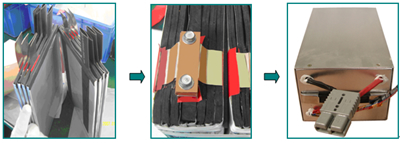Enginer PHEV Latest Improvements
Batteries:
- New and advanced lithium-ion battery materials and structure ensuring safety, stability and high capacity
- Two assembled battery packs replacing previous 32 individual cells, with quick connections to other components
- Built-in temperature sensors. Should overheat does occur, BMS will disconnect the charger or shutdown the converter to prevent thermal event

Charger:

- System total voltage reduced from 58.3 V to 55.5 V to avoid over charge;
- Improved charging profile with fastàtrickle charging currents to prevent system from over-charge;
- Trickle current charging maintains stable cell voltages while charging batteries fully;
- Timer based charging avoids non-stop charging to enhance safety.
DC-DC Converter:
- Upgraded from previous 3KW to the current 5KW output, enabling almost non-stop All-EV drive till all batteries are depleted;
- Inside and outside ventilation improvement reduces system operating temperature;
- High standard production techniques and top quality electronic components used;
- Neat and trendy design and structure.

Battery Management System:

- Highly efficient and fully functional inductive active BMS monitors, balances and manages batteries, with 2A charging current to any individual lower cell.
- Disconnecting the charger to avoid over-charge once an individual cell exceeds 3.8V.
- Disconnecting the converter to avoid over-discharge if an individual cell drops below 2.0V.
Wiring:
- Streamlined wiring for charger, batteries, BMS, converter, circuit breaker connections;
- Nickel electrophoretic coated copper terminal connectors and screws on batteries to reduce internal resistance;
System Structure:
- Reduced enclosure box height to allow trunk floor cover being fastened easily;
- Re-designed enclosure box handles without large nuts inside leaving inner sides flat for easy battery installation / maintenance;
- Integration of enclosure box with mounting brackets and the use of pivot nuts simplify system installation, saving at least one hour installation time;
- Strong fire extinguisher holder;
- Rubber plates under enclosure box to absorb shocks (Prius original heat insulating felt on right hand side of trunk bottom should be kept);
- Easy install, more durable and professional look driver’s switch panel;
* Structure improvements largely reduce installation time from previous 4-8 hours to 2-4 hours.
* Plug-in Hybrid Electric Vehicle Conversion (PHEV)
The 4-KWh kit provides up to 20EV / 40 blended miles range per charge which will save about 260 gallons of gasoline per year. You could double your savings to 520 gallons if you charge at least twice a day.
 PHEV upgrading system is not limited to Prius PHEV conversions. The technology can be applied to any hybrid vehicle or even electric car. If
PHEV upgrading system is not limited to Prius PHEV conversions. The technology can be applied to any hybrid vehicle or even electric car. If  PHEV system is adapted in a new vehicle, the vehicle will be qualified for $2500 federal tax credit according to the Recovery Act.
PHEV system is adapted in a new vehicle, the vehicle will be qualified for $2500 federal tax credit according to the Recovery Act.
Note: Actual results may vary. PHEV efficiency depends upon your driving style, speed, distance, terrain, and charge frequency.
PHEV System Specifications »
| System Specs |
| Structure: |
Stainless steel enclosure box |
| Position: |
On top of spare tire compartment and under trunk |
| Safety: |
Auto-operating fire extinguisher inside |
| Conversion Time: |
2 hours by professionals |
| Charge Time: |
3-8 hours on any 110VAC outlet
220VAC input systems also available for other countries |
| Voltage: |
48 VDC nominal |
| Net Weight: |
2KWH - 120 lbs
4KWH 180 lbs
8KWH 300 lbs |
| Capacities : |
2KWH ( up to 10 EV / 20 blended miles)
4KWH ( up to 20 EV / 40 blended miles)
8KWH ( up to 40 EV / 80 blended miles) |
Note: Californian buyers are subject to an extra $1,000 cost due to extended warranty for 5 years and certification, for CARB compliant.




 PHEV upgrading system is not limited to Prius PHEV conversions. The technology can be applied to any hybrid vehicle or even electric car. If
PHEV upgrading system is not limited to Prius PHEV conversions. The technology can be applied to any hybrid vehicle or even electric car. If  PHEV system is adapted in a new vehicle, the vehicle will be qualified for $2500 federal tax credit according to the Recovery Act.
PHEV system is adapted in a new vehicle, the vehicle will be qualified for $2500 federal tax credit according to the Recovery Act.